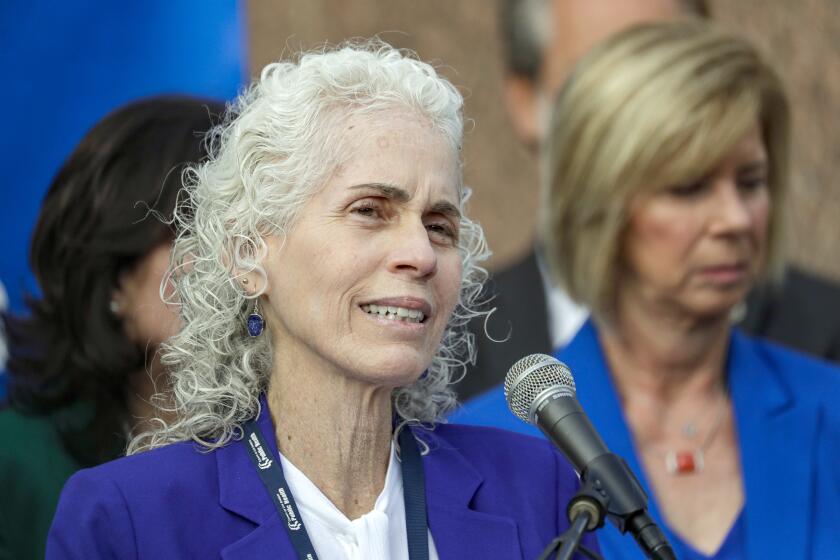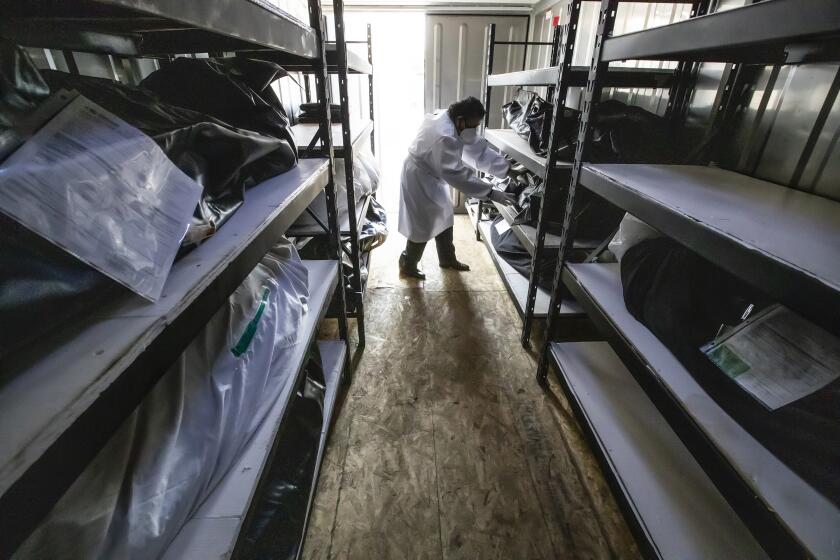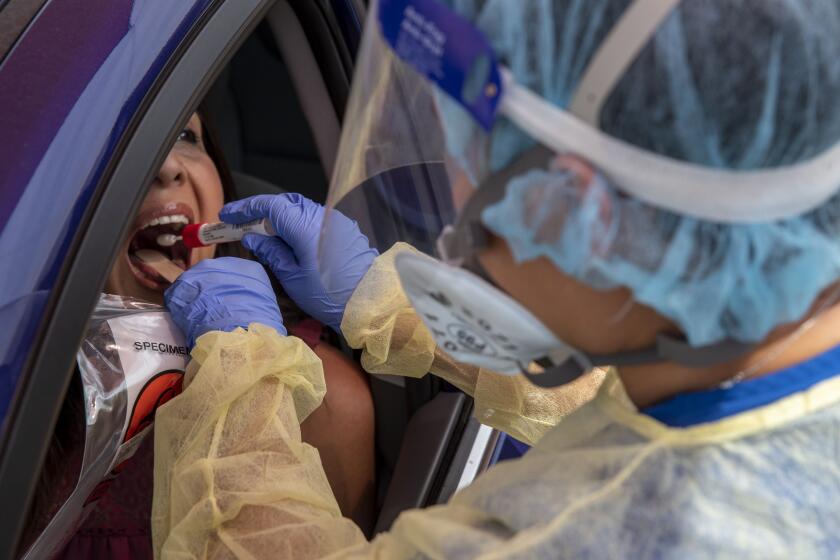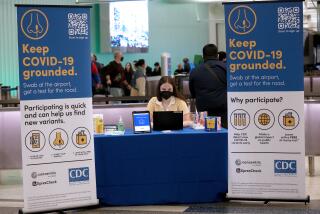California coronavirus deaths hit stubborn plateau; experts fearful about future
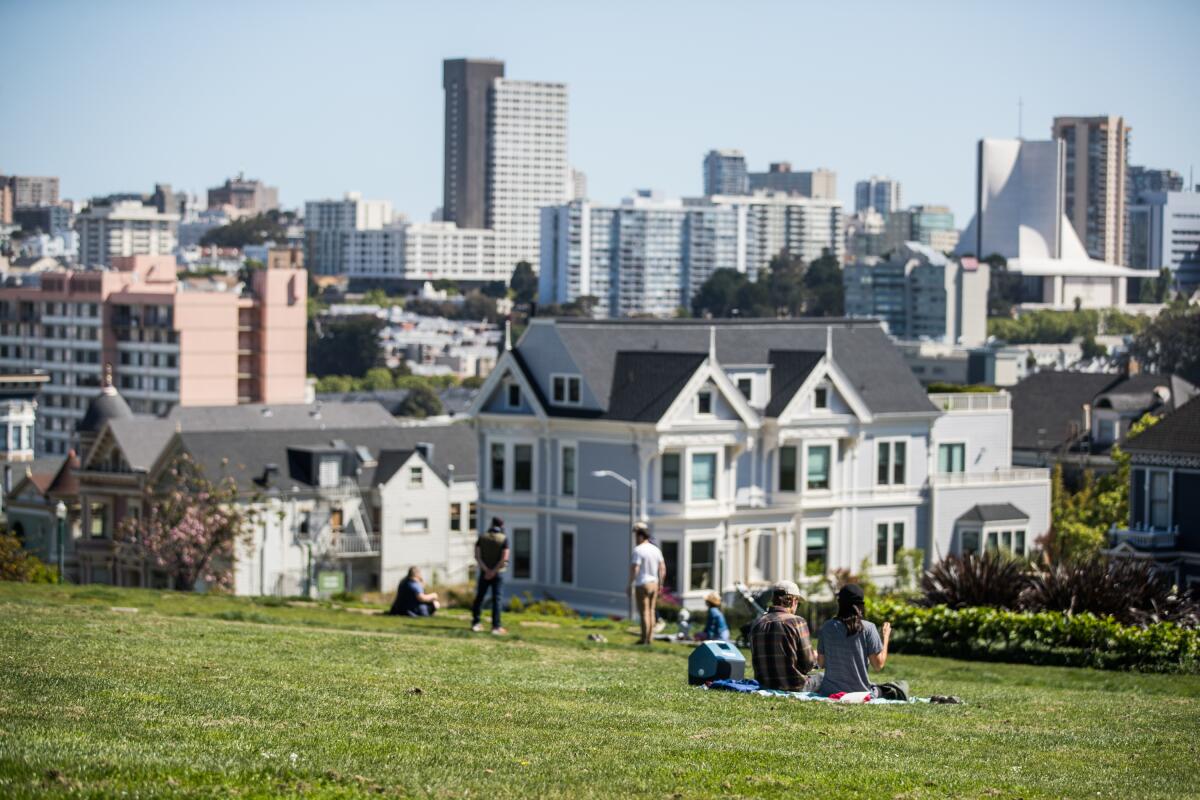
SAN FRANCISCO — Although some hope the worst of California’s coronavirus crisis has passed, there are signs the pandemic in the Golden State has merely stabilized, and the worst may be yet to come.
The number of weekly COVID-19 deaths in California has hit a stubborn plateau, and the number of cases has not begun a sustained week-over-week decline, a Los Angeles Times analysis has found. For the seven-day period that ended Sunday, 503 people in California died from the virus — the second-highest weekly death toll in the course of the pandemic and a 1.6% increase from the previous week.
In fact, the latest tally shows that the death toll has continued to average about 500 fatalities each week over the past month. The week before last, there were 495 deaths. Prior to that, there were 542 fatalities, and the week before that, 497.
Coronavirus cases shot up to a new weekly record last week, with more than 13,000 new infections reported.
On Sunday, an influential coronavirus forecast projected a worsening death toll by early August. The University of Washington’s Institute for Health Metrics and Evaluation now forecasts a California death toll of more than 6,000 by early August, up from 4,600 from a forecast issued a week ago — an increase of more than 1,400 deaths.
“If we were to see the kind of spike that’s predicted in that model, that would be extraordinarily worrisome,” said Barbara Ferrer, director of public health for Los Angeles County, which so far has seen 56% of all of California’s coronavirus deaths despite being home to one-quarter of the state’s population.
If the model’s projections became reality, Ferrer said that would result in an even slower reopening of society in L.A. County or force the nation’s most populous county to reimplement stricter stay-at-home measures. L.A. County implemented its first major easing of stay-at-home measures on Friday, allowing some retail businesses to open for curbside pickup, and plans to reopen beaches for active recreation this week.
In California, coronavirus cases and deaths are rising faster than researchers expected, according to the latest calculations in a widely relied-upon model of the COVID-19 outbreak.
California is among eight states predicted to see the largest increases in projected cumulative deaths, according to a forecast issued May 4 and updated Sunday. This group of states included Pennsylvania, Illinois, Arizona, Florida, Mississippi, Missouri and Connecticut. As a whole, the U.S. is now projected to record more than 137,000 deaths by early August, up from a forecast of over 134,000 issued last week.
The U.S. death toll was more than 80,000 as of Monday, an astonishing total that has accumulated in less than three months. It has exceeded the death toll of the Vietnam War, in which more than 58,000 members of the U.S. Armed Forces died, and has surpassed the total number of deaths in the 2018-19 flu season, which was 34,200, and the preceding flu season, which was 61,000.
The U.S. death toll — 200,000 — from the coronavirus has passed the total from WWI and the Vietnam War combined. Here’s a look at COVID-19’s place in history.
Experts attribute the rising forecast of coronavirus-linked deaths to the public growing more weary of stay-at-home orders, as well as moves across the nation to roll them back. California is in its eighth week of statewide restrictions aimed to stop the spread of the coronavirus.
“We’re seeing just explosive increases in mobility in a number of states that we expect will translate into more cases and deaths, you know, in 10 days from now,” the director of the Institute for Health Metrics and Evaluation, Dr. Chris Murray, said Sunday on the CBS program “Face the Nation.”
Experts say the number of cases will grow as testing capabilities increase. Still, tracking the number is still seen as a useful indicator, as at some point, scientists expect testing capacities will eventually catch up to the demand.
As government officials begin rolling back restrictions, health experts have urged caution and pushed back against the idea that officials need to choose between the economy and public health.
Reopening society at a dangerous pace and then being hit by a spike in deaths would shatter public confidence and hurt the economy further, they said. Polls show that large majorities want to move slowly on ending stay-at-home orders.
“We have to show people that this disease is under good control, and people will then have confidence in going out and reengaging the economy,” Dr. Thomas Inglesby, director of Johns Hopkins’ Center for Health Security, said on Fox News on Sunday.
California is still in its first wave of cases
California officials have noted the state’s death toll — which sits at more than 2,700 — is markedly lower than New York’s, with over 26,000 dead, or New Jersey’s, more than 9,000.
But there are many more Californians who haven’t been infected yet.
It would be a mistake to think California has turned the corner, experts say.
UC San Francisco epidemiologist and infectious disease expert Dr. George Rutherford, a former epidemic intelligence service officer with the U.S. Centers for Disease Control and Prevention, said California hadn’t left its first wave of cases.
“As long as it’s going up, it has not ended,” he said. “It’s got to come down for it to end.”
Nationally, too, “we’re in a steady state,” Rutherford said, “with about 25,000 to 30,000 cases of COVID being reported daily nationwide.”
Health officials in both Los Angeles County and San Francisco also warned that key pandemic indicators have also merely stabilized and haven’t gone down.
L.A. County has seen the average weekly number of deaths remain constant at around 300 a week for each of the past four weeks.
In San Francisco, the number of hospitalized people with confirmed or suspected coronavirus infections has remained steady since mid-April, averaging at 100 for the last three weeks.
“It is not decreasing substantially,” the San Francisco director of public health, Dr. Grant Colfax, said Monday.
More infections among minorities
Although Latinos make up 39% of California’s population, they make up about half of all positive cases in the state.
Native Hawaiians/Pacific Islanders also are being diagnosed at a rate greater than their demographic in the population, Rutherford said.
Blacks are dying at a disproportionately higher rate in California. Blacks made up 10% of total deaths, higher than the 6% share they comprise in California’s population. Asian Americans, Native Hawaiians and Pacific Islanders are dying at a slightly higher rate than their share of California’s population.
About half the people in California being diagnosed with COVID-19 are adults under the age of 50. Rutherford called that “a surprisingly large number.”
People in areas with high poverty rates have nearly four times as many deaths from COVID-19, L.A. County public health director Barbara Ferrer says.
‘Headed for potentially a very large outbreak in the fall’
Experts expect the number of fatalities to grow nationally.
“We’re headed for potentially a very large outbreak in the fall, which will make whatever we’ve seen pale in comparison,” Rutherford said. It’s possible, he said, that children could further spread the disease when they return to school in the fall.
In the 1918-19 flu pandemic, the first wave occurred in the early summer of 1918 but noticeably receded by mid-summer.
A second wave, far deadlier than the first, started in the fall and did not let up until the beginning of winter. Then, a third wave picked up in late winter, persisting through the springtime.
This COVID-19 pandemic is different. Instead of deaths declining, they’ve stabilized, but at a higher level.
Rutherford says there’s a risk that some states that are opening up too quickly will see a rising death toll — and the effects of the pandemic will disproportionately hit Latinos and blacks.
Rutherford says society does need to reopen — it’s too destructive to continue to be closed — but that it should be done carefully.
“If we have a prolonged depression, that has tremendous costs in morbidity and mortality as well. So it’s a tradeoff: Just understand that we’re trading economy for lives,” Rutherford said.
“Make no mistake … the more the economy opens up, the more people are going to die,” he added. “You have to be really careful to minimize that number and make sure it’s not on the backs of all the poor people who are doing the front-line jobs who are going to get the most exposed.”
Lin reported from San Francisco, Lee from Los Angeles.
More to Read
Sign up for Essential California
The most important California stories and recommendations in your inbox every morning.
You may occasionally receive promotional content from the Los Angeles Times.
